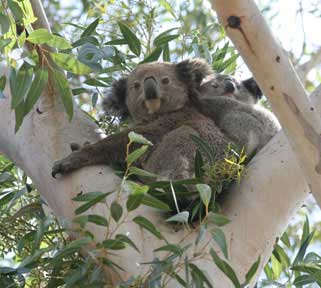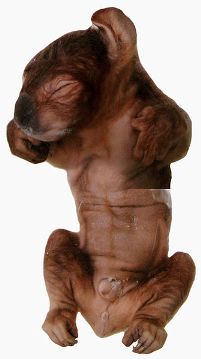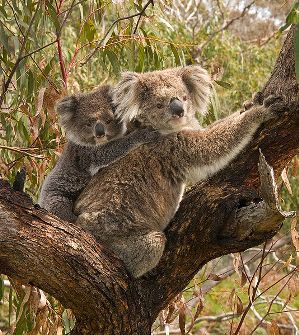Reproduction
Reproduction is a vital state for all animals including koalas because it keeps the species alive from generation to generation. Reproduction is fascinating in all animals, but especially in marsupials because of the pouch that mothers provide to raise their young in. It is a neat relationship between a koala mother and their joey. Koalas are dioecious animals that reproduce sexually. This means there are separate male and female koalas and a male and female are required to sexually mate, fertilization of sperm and egg, to produce offspring.
Females are reproductively mature at the age of two to three years or an average mass of about 13 pounds, while males are normally four years old. Males are often older because they will be larger and females favor bigger males (Animal Diversity Web 2001). Males attract females through vocal calls. These signals are critical for mating. Males use a low-pitched bellow that consists of a series of inhales followed by short, burp-sounding exhales (Charlton 2011). Males do the majority of calling as females rarely call out to males. Once a female decides she will mate with the male, she follows the bellow to find the male. Each male has its own unique sound for a signal so that females are able to differentiate males from one another (Charlton 2011). Click here to hear a koala bellow.
Koalas have seasonality reproduction. This means they reproduce only during certain times of the year. They reproduce in the summer and autumn months which in Australia consists of October to May, with a high reproduction rate from December to March (Ellis 2010). The mating season is not concrete as there is some slight variation in the season. This includes variation in Northern and Southern Australia, as well as in slightly different environments. For example, in some areas of Southeastern Queensland, when rainfall is heavy, resources are in abundance therefore making a prime time to raise a young (Ellis 2010). Koalas roam around more freely during their breeding season (Charlton 2011). This is most likely due to the process of finding their mate.
After a male and female koala mate, the female conception period is 25 to 35 days. The young joeys are then born weighing less than .5 grams. They immediately attach to a nipple in the pouch of the mother koala. They remain in the pouch anywhere from five to seven months. Once the young begins eating leaves on their own, they leave the pouch and crawl onto the mother’s back where the mother carries them until they are around one year old (Ng 2001). After a year the young becomes an independent koala and slowly moves away from its mother. Female koalas are able to produce one young each year until they reach the age of ten which is close to the end of their life span (Whisson 2010). Marsupial animals are unique in that they raise their young in a pouch instead of inside their body. We most commonly associate kangaroos with pouches to raise their young, but now you can add koalas to your list!


